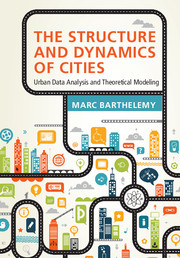Book contents
4 - Infrastructure networks
Published online by Cambridge University Press: 10 November 2016
Summary
Infrastructure such as transportation networks for individuals and freight, power grids or distribution systems is crucial for our societies and the good functioning of cities. All these networks are embedded in space: nodes have a position and links have a certain length, and hence a cost associated with their formation and maintenance. These “spatial networks” (Barthelemy 2011) necessitate specific tools for their characterization and in this chapter we first review some of the most important ones. We then focus on transportation networks, starting with the road and street network, followed by subway networks. We end this chapter with a digression on the railroad network and we discuss the importance of the spatial scale and the main differences between subways and railroads.
Roads and streets: patterns
An important component of cities is their street network (in the following we will not make the distinction between streets and roads). These networks are made of nodes that represent the intersections and the links are segments of roads between consecutive intersections. These networks can be thought as a simplified view of cities, that captures a large part of their structure and organization (Southworth and Ben-Joseph 2003), and contains a large amount of information about underlying and universal mechanisms at play in their formation and evolution. Identifying the main mechanisms in these systems is not a new task (Haggett and Chorley 1969; Xie and Levinson 2011), but the recent availability of digitized maps, historical or contemporary (see Chapter 1), allows us to test ideas and models on large-scale cross-sectional and historical data.
Street networks are approximatively planar graphs and are now fairly well characterized (Jiang and Claramunt 2004; Rosvall et al. 2005; Porta et al. 2006b,a; Lämmer et al. 2006; Crucitti et al. 2006; Cardillo et al. 2006; Xie and Levinson 2007; Jiang 2007; Masucci et al. 2009; Chan et al. 2011; Courtat et al. 2011).
- Type
- Chapter
- Information
- The Structure and Dynamics of CitiesUrban Data Analysis and Theoretical Modeling, pp. 78 - 128Publisher: Cambridge University PressPrint publication year: 2016



